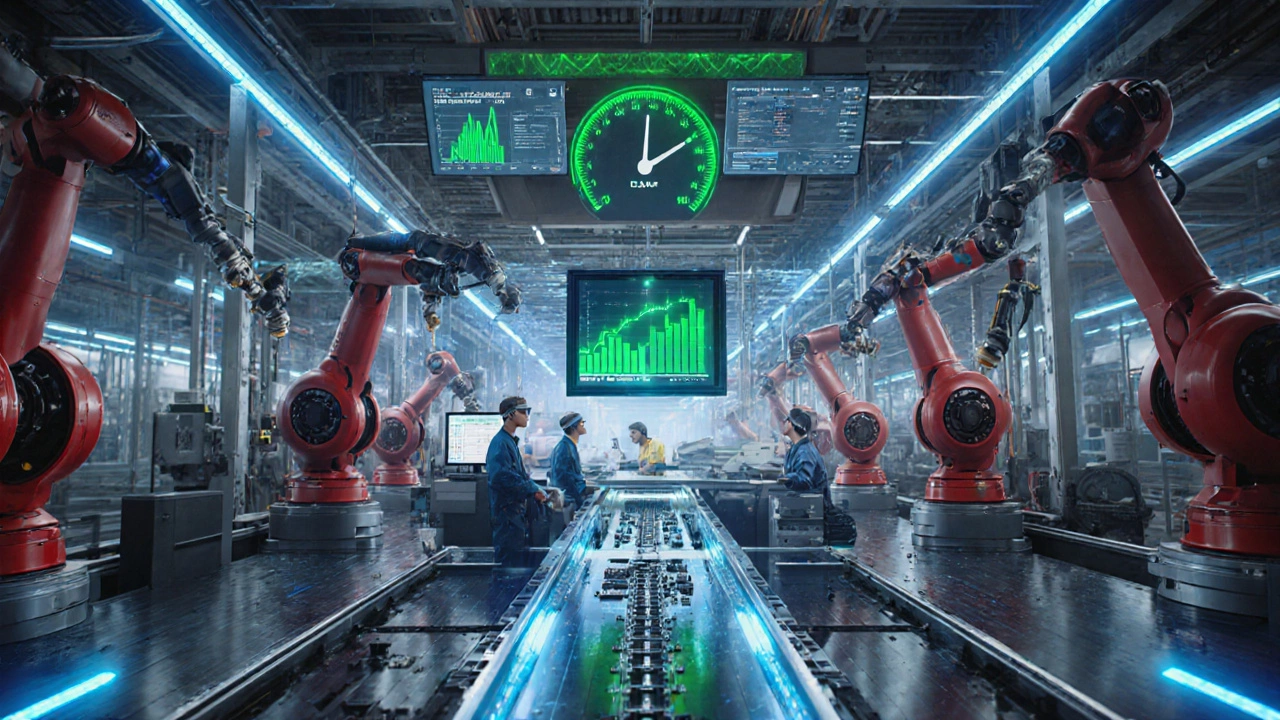 Oct, 9 2025
Oct, 9 2025
Manufacturing Profitability Calculator
This calculator helps assess the potential profitability of different manufacturing sectors based on average EBITDA margins and risk factors. Enter your investment amount to see projected returns.
Pharmaceuticals
High margins with stable demand. Average EBITDA margin: 20-25%
High ProfitabilityElectronics
Moderate margins with high growth potential. Average EBITDA margin: 12-15%
Medium ProfitabilityTextiles
Lower margins due to competition. Average EBITDA margin: 5-8%
Low ProfitabilityAutomotive
High volatility but strong long-term potential. Average EBITDA margin: 8-12%
Medium-High ProfitabilityResults
Enter your investment amount and time period, then click Calculate to see projected returns for different manufacturing sectors.
When investors ask whether manufacturing industry is a cash‑cow, they’re really hunting for numbers that prove the sector can turn capital into profit faster than other businesses. The short answer is yes - but only if you pick the right sub‑sector, control costs, and ride the wave of automation.
Key Takeaways
- Average EBITDA margins vary widely: pharma (~20‑25%), electronics (~12‑15%), textiles (<5%).
- Capital intensity is the biggest profit driver; high‑tech factories recoup investments in 5‑7 years.
- Automation can lift margins by 3‑7 percentage points.
- Regulatory compliance and supply‑chain volatility are the top risk factors.
- A simple 7‑step profitability checklist helps you decide if a specific manufacturing venture is worth the money.
What Makes Manufacturing Profitable?
Profitability in any industry is measured with a few core metrics: gross margin, operating margin, and especially EBITDA (Earnings Before Interest, Taxes, Depreciation, and Amortisation). In manufacturing, EBITDA is favoured because it strips out capital‑heavy depreciation, giving a clearer view of cash‑flow performance.
EBITDA margin typically ranges from 5% in low‑tech, labour‑intensive sectors to over 20% in specialised pharma or aerospace. The spread tells you where the real money lives.
Another crucial figure is manufacturing profitability. It blends margin, capital turnover, and growth potential. A high‑margin but capital‑starved operation can still be unattractive if the payback period exceeds 10years.
Major Factors Driving Profitability
Three forces dominate the profit equation:
- Capital intensity - the amount of money tied up in plant, machinery, and tooling. Heavy‑cap sectors like automotive need billions upfront, but they also enjoy economies of scale.
- Automation - robots, AI‑driven quality control, and Industry 4.0 data platforms. Studies from the International Institute of Manufacturing (2024) show a 4% lift in margin for every 10% increase in automated processes.
- Labor cost - wages, benefits, and turnover. Countries with low‑cost skilled labour (Vietnam, Mexico) often beat higher‑cost locations on net margin, provided they can maintain quality.
These three interact. High automation reduces labor cost, but it raises capital intensity. The sweet spot is a balanced mix that yields a payback period of 5‑7years.

Profitability by Sub‑Sector
| Sub‑Sector | Avg. EBITDA Margin | Capital Intensity (USDbn per 1M units) |
Growth Rate (YoY) |
|---|---|---|---|
| Pharmaceutical Manufacturing | 22% | 0.45 | 8% |
| Electronics Manufacturing | 14% | 0.30 | 6% |
| Automobile Manufacturing | 9% | 0.70 | 3% |
| Food Processing | 11% | 0.20 | 5% |
| Textile Manufacturing | 4% | 0.15 | 2% |
Notice how pharma and electronics lead on margin, while textiles lag far behind. Capital‑intensive sectors still manage decent margins when they harness automation and secure premium contracts.
Risks That Eat Into Profits
Even the most promising factories can see profits evaporate if they ignore three looming threats:
- Supply‑chain risk - raw‑material price spikes, geopolitical disruptions, and logistics bottlenecks. The 2022‑2023 semiconductor shortage alone shaved 2‑3% off electronics margins.
- Regulatory compliance - stricter emissions standards, safety audits, and trade tariffs. Non‑compliance can lead to fines exceeding 5% of revenue.
- Sustainability pressure - investors now demand ESG (Environmental, Social, Governance) reporting. Green retrofits add 10‑15% to CAPEX but can open premium market channels.
Mitigating these risks often requires a blend of strategic sourcing, active lobbying for favourable government incentives, and early adoption of circular‑economy practices.
7‑Step Checklist to Judge a Manufacturing Venture
- Identify the sub‑sector and collect recent EBITDA margin benchmarks.
- Calculate required capital spend per unit of output and estimate the payback period.
- Map the supply chain: check for single‑source critical inputs and evaluate price volatility.
- Score the automation potential - percentage of processes that can be robotised within 3years.
- Assess labor market: wage rates, skill availability, and turnover risk.
- Research applicable government incentives (tax credits, subsidies, export grants).
- Run a scenario analysis - best case (full automation, stable supply), base case (moderate automation), worst case (regulatory shock).
If the base‑case ROI exceeds 15% and the payback stays under 7years, the venture is likely lucrative.

Real‑World Snapshots of High‑Margin Manufacturers
Case 1 - Pharma Startup “BioCure” (2022‑2024): Leveraged a 30% automation line for sterile injectables, hit a 23% EBITDA margin within two years, and secured a US‑FDA fast‑track status that unlocked a 12% tax credit.
Case 2 - Electronics OEM “CircuitForge” (2021‑2025): Invested $200M in AI‑driven defect detection, lifted margin from 11% to 15%, and cut scrap rates by 40%.
Case 3 - Food Processor “GreenHarvest” (2020‑2024): Adopted a renewable‑energy micro‑grid, qualified for a €5M sustainability grant, and raised EBITDA margin from 9% to 12% while entering the EU organic market.
All three examples share the same recipe: high automation, strategic use of incentives, and focus on niche, high‑value products.
Future Outlook - Will Manufacturing Get More Lucrative?
Three trends suggest profit potential will rise:
- Industry 4.0 adoption - by 2027, Gartner predicts 65% of midsize factories will have integrated digital twins, improving yield by up to 8%.
- Growing demand for near‑shoring as companies seek to shorten supply chains, opening new markets for local manufacturers.
- Increasing ESG premiums - investors are willing to pay up to 12% more for companies that meet carbon‑neutral targets, translating into higher valuation multiples.
That said, the upside hinges on managing the risk pillars mentioned earlier. Companies that treat automation and sustainability as cost centres rather than profit drivers will lag behind.
Frequently Asked Questions
What is the average profit margin for manufacturing companies?
Across all sub‑sectors, EBITDA margins typically sit between 5% and 22%. High‑tech areas like pharma and electronics pull the average up, while labour‑intensive fields such as textiles sit near the low end.
How does automation affect manufacturing profitability?
Automation cuts labor costs, reduces scrap, and speeds up production cycles. A 10% rise in automated steps usually adds 3‑7percentage points to EBITDA margin, while also shortening the payback period on capital spend.
Are there government incentives that improve manufacturing ROI?
Yes. Many countries offer tax credits for R&D, grants for green‑energy retrofits, and export‑promotion subsidies. In the US, the 45X Advanced Manufacturing Credit can offset up to 20% of qualified equipment costs.
What risks should I watch for when investing in a factory?
Key risks include supply‑chain disruptions, regulatory changes (especially environmental and safety standards), and labour shortages. Conducting a scenario analysis helps quantify their impact on ROI.
Is it better to start a low‑capex or high‑capex manufacturing business?
Low‑capex models (e.g., contract assembly) have quicker break‑even points but lower margins. High‑capex ventures (pharma, aerospace) demand larger upfront spend but can lock in premium margins and stable cash flow once the plant is online.